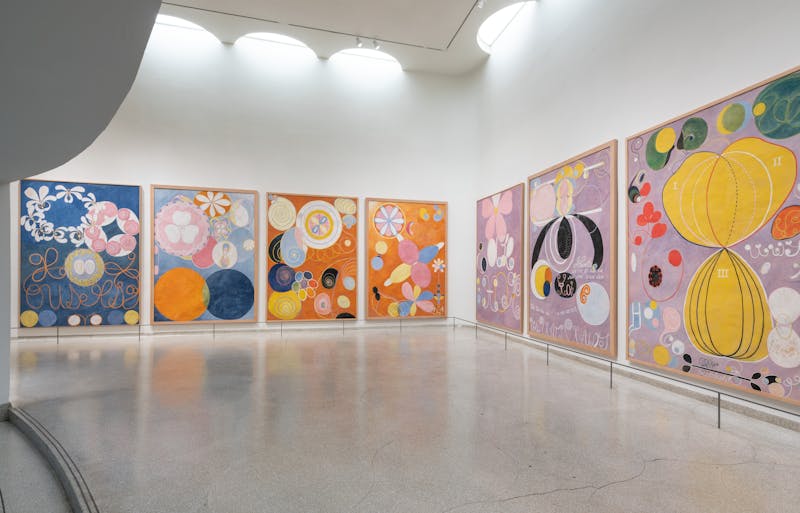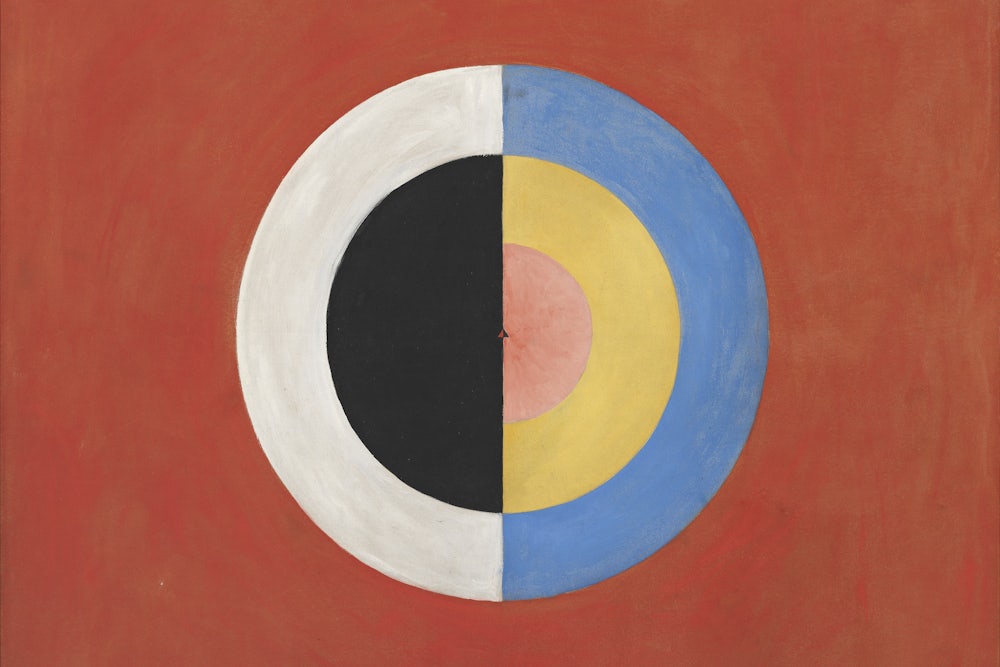In January 1906, Hilma af Klint was offered an unusual commission. For years, the Swedish artist had been meeting with four female friends to pray, meditate, and hold séances, in which they attempted to contact a set of spiritual guides they called the High Masters. The women, who dubbed themselves The Five (De Fem), took notes and made automatic drawings during their sessions.
In 1904, the Masters (who had names: Amaliel, Ananda, Clemens, Esther, Georg, and Gregor) told af Klint of a forthcoming task: a temple should be built and filled with paintings representing the spiritual world. Over the next two years, the guides spoke to the other members of The Five, asking them if they would be willing to undertake the project. All declined. At the start of the new year in 1906, Amaliel offered it to af Klint, who accepted immediately. “This became the great commission, which I carried out in my life,” she wrote.
The 43-year-old artist prepared for months and then began making The Paintings for the Temple. She continued, working on and off, for nine years. In all, she created 193 paintings that are divided into series and further subdivided into groups, with numbered and often pictorial progressions. The works are colorful, schematic, abstract, and filled with geometric shapes, fluid forms, and cryptic language. Some stretch as tall as ten feet; others measure barely a foot wide. Cosmic and primordial, mysterious yet deeply moving, they are nothing short of astonishing. And more than a third of them can now be seen at the Guggenheim Museum, in Hilma af Klint: Paintings for the Future, the most significant exhibition ever devoted to the artist in the United States.
The show opens with a gut punch: temple paintings from a group titled The Ten Largest, hanging side by side along the walls of an alcove gallery just off the Guggenheim’s main ramp. The towering works (exact sizes vary, but they’re all around 10.5 feet high and just shy of 8 feet wide) represent the stages of life: There are two for childhood, two for youth, four for adulthood, and two for old age. Each phase has a corresponding background color: blue, orange, purple, and pale pink. Constellations of rounded shapes and swirling lines, and bits of cursive writing, float against the backgrounds in those same colors, as well as harmonious shades of yellow, green, black, and white. Much of the imagery suggests natural and biological forms, like flowers, clitorises, and planets, but in other places, circles and squares just represent themselves. The picture planes are flat but undeniably kinetic—all the elements look as though they might shake loose and start drifting at any moment.
Even by today’s standards, The Ten Largest are unique in the way they mix the iconographies of scientific charts and occult diagrams with a kind of geometric abstraction that, in contrast to the prevailing trends of the Western canon, we might call “soft edge.” But these paintings were made in 1907. In 1907, the Russian artist Wassily Kandinsky hadn’t yet published On the Spiritual in Art, his landmark treatise on nonobjective painting, nor made his first abstract work. Neither had Kazimir Malevich or Piet Mondrian, the men considered the other pioneers of abstraction, made theirs. In 1907, none of the modern art being shown—and as far as we know, created—in Western countries looked anything like The Ten Largest. This is what makes the series, and af Klint’s work more generally, so breathtaking: It demonstrates completely different possibilities for what art can be. And it was made more than 100 years ago, by a woman.
Contrary to what the spirit guides and the proto-abstraction might suggest, af Klint was a classically trained artist. Born into a prominent family of naval officers and raised mostly in Stockholm, she attended the Royal Academy of Fine Arts, which gave her shared studio space in a neighborhood central to the city’s art scene after she graduated in 1887. In fact, the studio was located just upstairs from Blanch’s Art Salon, where Edvard Munch had a show in 1894. Af Klint was clearly attuned to the developments of modernism, while she made and exhibited realist portraits, landscapes, and studies of nature. (She also did scientific drawing, co-illustrating a book on horse surgery in 1900.)

Some of her naturalistic works are on view at the Guggenheim, just beyond the gallery containing The Ten Largest. They include delicately rendered watercolors of flowers and lifelike drawings of women, as well as an oil painting, “Summer Landscape” (1888), that suggests an aptitude for rendering light. It’s hard to believe that these traditional, if thoughtful, works are by the same artist as The Paintings for the Temple.
Not only that, but she sometimes made them around the same time. The story of af Klint’s artistic development does not progress along a straight line. Even as she plunged into her spiritual paintings, which she displayed publicly only once in her lifetime, she continued to create and exhibit naturalist art. The 1914 Baltic Exhibition, a sort of world’s fair in Malmö, included abstractions by Kandinsky, but af Klint opted to show her realist side.
Her reluctance to share her more radical art may have had something to do with a meeting with Rudolf Steiner. Af Klint was an ardent seeker who looked to many religions and belief systems, including spiritualism, Christianity, Theosophy, and Steiner’s creation, Anthroposophy, for knowledge about the universe. In 1908, she met Steiner and invited him to visit her studio, where he looked at some of her temple works. She explained that she had made them as a medium, by channeling the Masters, who guided her to paint. Steiner was critical of both the approach and the art. After the visit, af Klint ceased painting almost entirely for four years. During that time she also cared for her mother, who had gone blind.
When she did begin again, she worked differently, now driven by a voice within and asserting more agency over her compositions, as Steiner had urged her to. Still, she continued to make partially or wholly abstract series whose shapes seem to contain the secrets of the world. A gorgeous trio of altarpieces from 1915 radiates cosmic, religious energy from its golden circles and divided triangles. Perhaps because of Steiner, however, she knew the world wasn’t ready to receive them. In 1932, in one of the many notebooks she used to meticulously catalogue her art, af Klint wrote that all the works annotated with certain symbols should not be opened until 20 years after her death.
It took a lot longer than that. Hilma af Klint died in 1944, at the age of 81. Her abstract work wasn’t shown publicly until 1986, when the Los Angeles County Museum of Art included some of her paintings in the exhibition The Spiritual in Art. As Daniel Birnbaum, the director of Stockholm’s Moderna Museet, recounts in the Guggenheim catalogue, “the reaction to that very first exhibition was one of enthusiasm but also of confusion and skepticism.” The critic Hilton Kramer was especially dismissive, writing of af Klint’s paintings, “To accord them a place of honor alongside the work of Kandinsky, Mondrian, Malevich, and Kupka … is absurd. Af Klint is simply not an artist in their class, and—dare I say it?—would never have been given this inflated treatment if she had not been a woman.”
The reaction this time around has been better. Most critics have acknowledged and celebrated af Klint’s vision, even if they don’t quite know what to make of it. But I can’t help thinking we’re still not quite ready for her—a woman who defied some of the crucial binaries that our culture stubbornly upholds. Af Klint was a trained artist who was also self-taught; she was insider as well as an outsider. She studied science and spiritualism. She made art as well as illustration. And in her art—often in the same series—she used figuration and abstraction, prizing neither one as a culminating achievement but rather drawing on both as they suited her needs.
Much of the debate and discussion around af Klint, at least in art circles, has centered on the question of whether she “got there first”—whether she made abstract paintings before the men. It seems obvious that she did, just not in a way we’ve been told counts as legitimate. A critical establishment that prizes rationalism and male ego is ill equipped to recognize the achievements of a woman who sought a higher purpose beyond herself. Never mind that Kandinsky also conceived of art as a means of spiritual expression. Or that Mondrian was also an adherent of Theosophy. Af Klint is dismissed as a “mystic” (according to one anecdote in the catalogue), because to accept her as an artist would mean having to revise the definition of who gets to be one.
It would take careful study of the more than 2,600 pages of writing she left behind—lexicons explaining the meanings of the letters in her paintings, notebooks cataloguing her work, book manuscripts—to begin to grasp what af Klint was trying to tell us, her future viewers. But you don’t need that esoteric knowledge to stand before her paintings and feel their challenge: to put aside what you’ve been taught and open yourself up to an unfamiliar and more expansive way of seeing the world.
